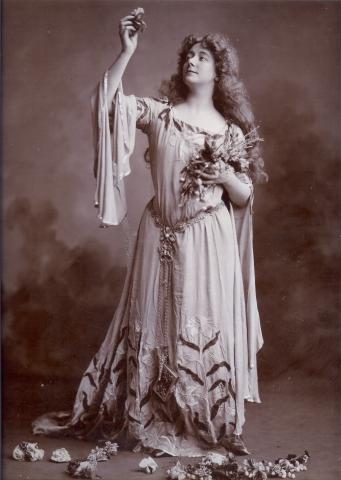
Cecilia Loftus as Ophelia, 1903. From the University of South Carolina Shields Collection and in the public domain by virtue of its age.
A major complication when looking at photographs from photography studios, such as Sarony’s, is that most of the time you cannot be sure of attribution. Did the proprietor take the photograph or was it taken by someone else in his employ. With Napoleon Sarony ‘s son Otto Sarony,(1850 – 1903) things get, well, complicated .
Otto was trained by his father to take over the family business. Indeed, he presided over almost every photo-session between 1893 and his father’s death in 1896 and he continued as sole proprietor from 1896 to October of 1898, when he sold the business and “all the fixtures, implements, cameras, lenses, specimens and materials used in about the photographic establishment . . . together with the trade-mark “Sarony'” to Jonathan Burrow. Such was the power and worth of the Sarony name. But then, as I said, things got complicated in 1902, when Otto sold the right to his name to photographic entrepreneur Theodore C. Marceau. Otto Sarony managed Marceau’s endeavor from Dec. 22, 1902, until his untimely death at age 53 in September 1903.
But it did not stop there. From 1903 onward photographs continued to be issued in under Sarony’s name or, perhaps better said, his label. In 1906 the Marceau Studio merged with the Otto Sarony Studio. The Otto Sarony label continued into World War I. The merger was thirteen year’s after Otto’s death, which means that the huge volume of images produced under his name were not taken by him at all, but by nameless and in many cases skilled portraitists.
This all makes the choice of a characteristic Sarony image a bit tricky. I have chosen as Figure 1 a spectacular photograph of Scottish actress Cissie (Ceclia) Loftus (1876-1943) in the role of Ophelia in Hamlet. There are hints of provenance however, since there is a chronology of Loftus’ major performances and Ms. Loftus is listed as performing Hamlet from from December 1902 to January 1903 and then again in March 1903. If we assume that the photograph was taken at the time of these performances it was done in 1902 or 1903. It dates therefore to the brief time of Otto’s management of Marceau’s Studio. This I guess puts it in the “possibly taken by Otto Sarony category” and if you add the significance of Ms. Loftus as a subject of the photograph it probably rises to “probably taken by” Otto Sarony.
This raises, perhaps, the question of why attribution is so important to us. Is it not the case that a photograph, if beautiful, remains beautiful even when it cannot be accurately attributed to a particular photographer? Certainly so, but I do think that there is added value when you have a body of a photographers work (literally a photographic habeas corpus, if you will), which enables you to get closer to his/her vision and progression as an artist. With so many artists of photography’s first century we must be content of single images.
